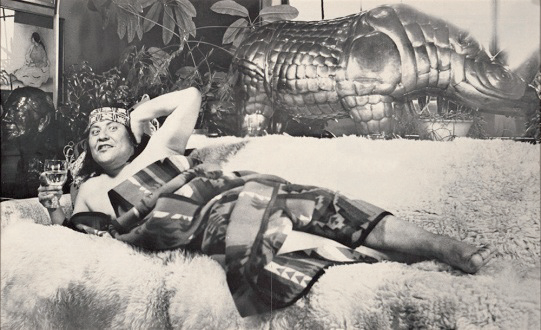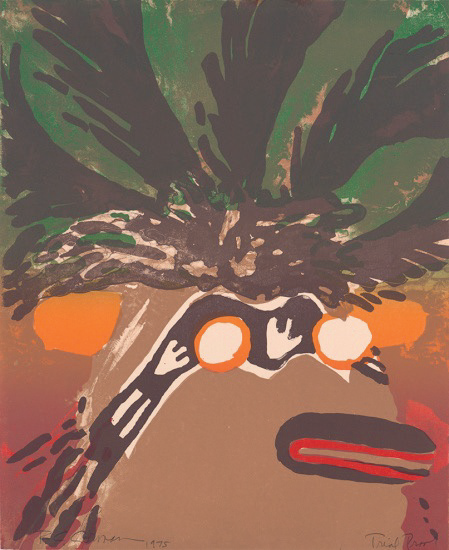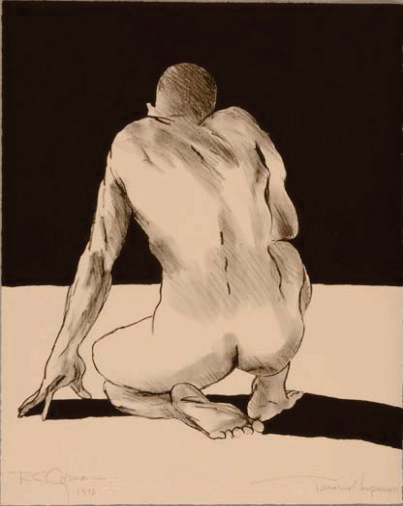 In light of the upcoming R.C. Gorman: The Early Years exhibit at the Harwood Museum of Art, we were standing around the restaurant the other day before service, dishing R.C. stories. There were plenty to tell, as R.C. was rather fond of the grape, and considerably forward with his libidinous overtures. Being on the receiving end of several blunt ones myself, I feel qualified to relay the following…
In light of the upcoming R.C. Gorman: The Early Years exhibit at the Harwood Museum of Art, we were standing around the restaurant the other day before service, dishing R.C. stories. There were plenty to tell, as R.C. was rather fond of the grape, and considerably forward with his libidinous overtures. Being on the receiving end of several blunt ones myself, I feel qualified to relay the following…
It was a late Friday afternoon in 2004. The chic, brand-spankin’-new Taos Resort had just opened, the dust still settling from construction crews. Per usual for a Friday, I had the wait staff assembled in a private dining room for a wine tasting before service.
The billionaire owner had quite an extensive cellar in the catacombs, and it served our palates well, giving us passport to the storied vineyards of the world. We were deep into it, the extensive table covered in crystal Riedel stemware — five or six glasses to each waiter, with about ten waiters in attendance, plus myself. I was talking about one thing or the other as we sniffed and swirled, when I noticed R.C. sticking his head in with entourage in tow.
Although he had recently made some inappropriate remarks to me while working the floor during dinner service, I knew it was who he was, and I believe it the responsibility of the Maître d’ to elegantly deal with any circumstance, regardless how difficult. So I invited them in, knowing that he truly appreciated a good wine, and I also wanted to show him there were no hard feelings.
At this point, R.C. was walking with a cane, but as it was R.C., it was a rather stately cane, a deep, polished wood with a brilliantly shiny silver handle which appeared to be a bird’s head, although I can’t say for sure as I was on the other end of the table, which easily sat 15 – 18. He sat down with his boys around him, big guys that looked as if they might be bodyguards had it not been for their simple Taos attire of t-shirts and scruffy jeans.
I poured him six tastes of — I believe — Syrahs from the Rhône and California. His eyes got big as he sniffed the first glass and downed its contents in one gulp, matter-of-factly placing the glass down in front of me while simultaneously giving me the look of a street urchin out of Dickens, begging for more.
I took a beat and looked him directly in the eye before I poured him another taste, adding, “There’s a spit-bucket next to you, should you need it, R.C.” — a statement which inexplicably drew a maniacal cackle from him, like the Penguin in the old Batman TV series, which lightened up the mood in the room, and soon there was boisterous discussion all around as we dangerously veered toward party mode.
We were running out of time and I still hadn’t discussed the wines in the depth I had hoped to, R.C.’s presence proving to be disruptive as he loudly commented on every wine he sniffed and shot. I vainly tried to get everybody back in line, but it was too late: mayhem had erupted.
I loudly declared the tasting over and was chatting with a small group of waiters, asking for help with getting all the glasses to the dishwasher, when suddenly…BOOM! a thunderous clap resounded through the room, echoing off its bare floors. Everyone froze in fear, as it sounded as if a shotgun had been fired.
The only sound left in its wake, R.C. laughing that Penguin laugh of his, his cane now broadly swept across the table in front of him, as the last glasses left standing gained enough momentum to roll off onto the floor, putting an exclamation point on the act. Apparently, he had been gesticulating wildly while telling one of his yarns about who knows what; cane in one hand, glass in the other, swinging the cane to and fro when the inevitable crash happened.
I can still remember the cold silence of the ensuing moments, all still in  shock and disbelief with that otherworldly cackle ringing through the room, R.C. laughing so hard he could barely breathe.
shock and disbelief with that otherworldly cackle ringing through the room, R.C. laughing so hard he could barely breathe.
His boys quietly went into action, pulling R.C. away from the shards of glass and taking the still-full glass out of his hand, while simultaneously apologizing profusely. I tried to downplay it, saying things like, “It’s fine,” and “Don’t worry about it.” But I knew at the moment my face was hot with anger, more for the wasted wine than anything else.
However, as the sea of broken glass was swept up and dealt with, I could feel my anger dissipating. R.C.’s boys had spirited him away and I could only hear him faintly in the distance, still laughing, saying things like, “Oh my god!”
 The Navajo creation myth depicts Coyote as a sort of necessary pain in the behind. Reminding us of our mortality, he represents the shadow side inherent in all of us. Just as there is a Yin and Yang, Coyote is necessary in depicting all facets of our existence, shedding light on the dark areas most choose to ignore when in the act of self-examination; much like the Grecian Oedipal moment, “Who did this terrible thing to our city! Oh my god, it was ME!”
The Navajo creation myth depicts Coyote as a sort of necessary pain in the behind. Reminding us of our mortality, he represents the shadow side inherent in all of us. Just as there is a Yin and Yang, Coyote is necessary in depicting all facets of our existence, shedding light on the dark areas most choose to ignore when in the act of self-examination; much like the Grecian Oedipal moment, “Who did this terrible thing to our city! Oh my god, it was ME!”
It’s in this light I chose to see R.C. The first time I laid eyes on him, I saw him for he was. There were too many parallels to our lives. We were both heavily influenced by the Mexican Muralists — particularly Diego Rivera — and we both had served as artist’s models, bearing our nakedness before strangers in the name of an ideal.
However, it was his attitude I appreciated more than anything else. R.C. walked with a swagger. He was a player and he knew it, as evident from this R.C. quote from the forthcoming show’s press release:
“I’ve always felt successful. Even when I wasn’t making money, I just knew it was all there. I always believed in myself. I knew I had the talent and there was just no doubt about it. I just didn’t give up.”
It’s this attitude that allowed R.C. to make it from the Navajo reservation to a joint show with Andy Warhol, as well as opening the first all-Navajo Gallery. He discovered Taos in 1964 — the year I was born — and fell in love with the place. Fate brought us together briefly, and while tragic at the time, that tasting is one of my fondest Taos memories, allowing me to recount an afternoon with a fellow Dionysian whose larger-than-life presence is still felt in this tiny village in northern New Mexico.
Witness the genius yourself at the Harwood Museum Saturday, May 18th – Sunday, September 8th, 2013.
